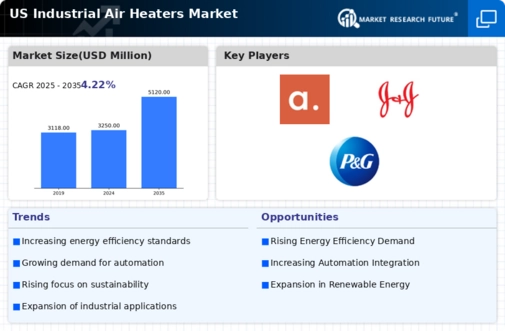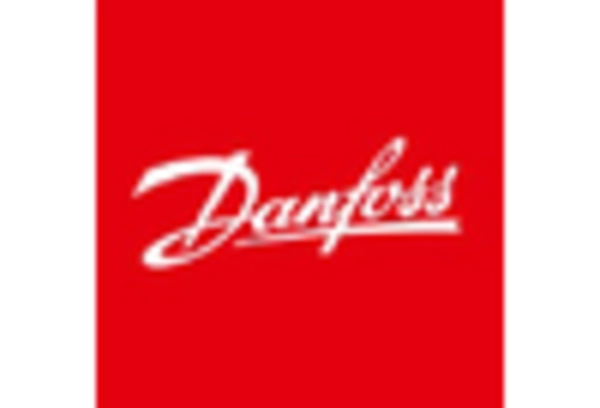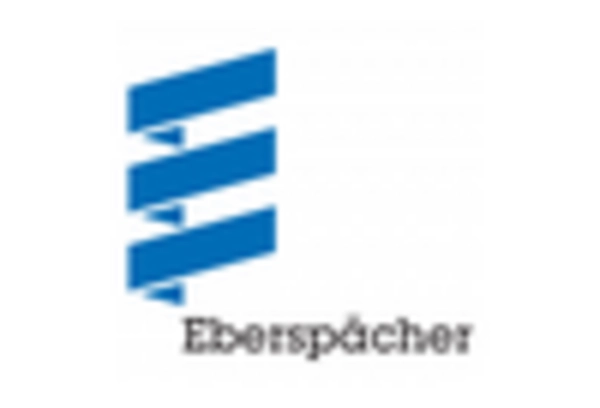Growth in Industrial Automation
The industrial air-heaters market is poised for growth due to the increasing trend of industrial automation. As industries adopt automated processes, the need for reliable and efficient heating solutions becomes paramount. Automated systems require precise temperature control to ensure optimal performance and product quality. This demand for accuracy and reliability in heating solutions is driving innovation within the industrial air-heaters market. Furthermore, the integration of smart technologies, such as IoT and AI, into heating systems enhances operational efficiency and reduces downtime. The market is expected to expand as more industries recognize the benefits of automated heating solutions.
Regulatory Compliance and Standards
The industrial air-heaters market is significantly influenced by stringent regulatory frameworks and compliance standards aimed at reducing emissions and enhancing safety. In the US, regulations set forth by agencies such as the Environmental Protection Agency (EPA) mandate that industrial heating systems meet specific efficiency and emission criteria. This regulatory landscape compels manufacturers to innovate and adopt advanced technologies that align with these standards. As a result, the market is witnessing a shift towards cleaner and more efficient heating solutions, which not only comply with regulations but also appeal to environmentally conscious consumers. The potential for penalties and fines for non-compliance further drives the adoption of compliant industrial air-heaters.
Rising Demand for Energy Efficiency
The industrial air-heaters market experiences a notable surge in demand driven by the increasing emphasis on energy efficiency across various sectors. Industries are actively seeking solutions that not only reduce operational costs but also minimize energy consumption. This trend is particularly evident in manufacturing and processing facilities, where energy costs can account for a substantial portion of overall expenses. According to recent data, energy-efficient heating solutions can lead to savings of up to 30% in energy costs. As companies strive to enhance their sustainability profiles, the industrial air-heaters market is likely to benefit from this shift towards more efficient technologies.
Expansion of Manufacturing Activities
The industrial air-heaters market is benefiting from the expansion of manufacturing activities across various sectors. As the US economy continues to recover and grow, manufacturing output is projected to increase, leading to higher demand for industrial heating solutions. Industries such as food processing, pharmaceuticals, and textiles are particularly reliant on effective heating systems to maintain production efficiency. According to industry reports, the manufacturing sector is expected to grow at a CAGR of 3.5% over the next five years, which will likely drive the demand for industrial air-heaters. This growth presents opportunities for manufacturers to innovate and cater to the evolving needs of the market.
Increased Focus on Indoor Air Quality
The industrial air-heaters market is increasingly influenced by the growing awareness of indoor air quality (IAQ) and its impact on worker health and productivity. Industries are recognizing that maintaining optimal air quality is essential for employee well-being and operational efficiency. As a result, there is a rising demand for heating solutions that not only provide warmth but also contribute to improved IAQ through effective ventilation and filtration systems. This trend is particularly relevant in sectors such as healthcare and food production, where air quality standards are critical. The industrial air-heaters market is likely to see innovations aimed at enhancing IAQ, thereby aligning with the broader focus on workplace health and safety.

















Leave a Comment